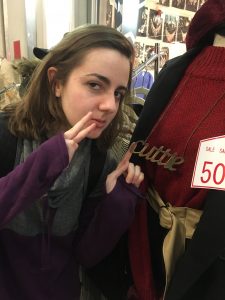At 9:25am, we lined up at the hostel lobby in order to walk to a shrine near Teramachi. There, we met Amae Derek-sensei, who would be talking to us about the way of tea, otherwise known as te mae, a “point in front.” Throughout our time of experiencing various arts and crafts within Kyoto, there was one theme that stood with me: the all-encompassing aspects that make each art and craft its own ensemble. In this case, we picked up water from a shrine. Derek-sensei pointed out the roof of the shrine building, covered in moss, showing how the shrine had not yet gotten the funds to replace it’s roof. In short, the shrine was low on funds, but purposely kept themselves local–while they could have opted to capitalize and sell fortunes and omamori, they consciously chose not to do so. The taking of this fresh, pure water was also a symbol of Shintoism: purity and honesty. In addition, the labor of taking the water and bringing it all the way back home to use in the ceremony, as well as the consciousness of using it as a limited resources were important features of the way of tea.
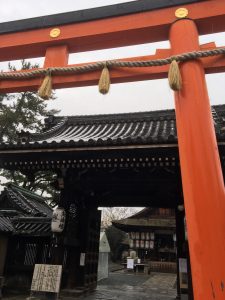
Despite Derek-sensei’s comments on how the heavy case of water would slow him down in order to also make him enjoy the beauty and nature around him, he walked particularly fast, and we shuffled to keep up behind him with the rising urban background of Kyoto behind us. We stopped to get matcha, where we also had a quick demonstration for how to make matcha tea at home, however, the art of temae is not about the tea tasting good, which is the goal of tea shops, but the whole act and process, from the fetching of water, to the final clean up. All these things act together and are thought about in focus as part of an active meditation. While the tea from the shop demonstration was indeed delicious, I was also interested in the taste of the whole experience that Derek-sensei would teach about.
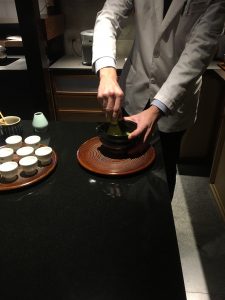
On our way, we also stopped by a wagashi shop, which was originally closed on Wednesdays, but takes orders. We popped in while Derek-sensei’s purchases were rung up, and he explained the shop to us. The wagashi-maker had been making sweets for about 6 years, and typically only had around 4 sweets at a time, based upon seasonal availability usually.
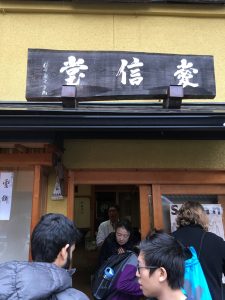
Finally, we took a couple buses to Derek-sensei’s house, which was near Daitokuji, as he was renting the house from the temple. In his house, we had a lecture in order to get into the “mind” for temae. Objects were passed around, and we were to concentrate on them. Of them, I was particularly interested in the tea bowl–it was asymmetrical and the rim couldn’t fully rest on the tray. There were areas that bulged out, the bottom was rough, and there was a crack in the cup that was filled in and also rough. Something about the many variations in texture, as well as the imperfectness of it attracted me. Funnily enough, I’m fairly sure that I was given this cup at the tea ceremony as well, as I could feel the crack and roughness of the bottom, as well as the bulbous-ness of the cup when I was drinking. We also looked at the tea tools afterwards, learning the proper way to pick them up, sort of as if you are picking up a newborn baby, as every tool is handled with care and equally, no matter if it is the hard, iron pot, or the fragile, light whisk. A proper posture is also similar to as if an invisible string was attached to your head, pulling upwards.
After this workshop, we went out to eat at a cafe that Derek-sensei recommended. It was a converted bathhouse, with tiles that are actually no longer made. After quite a bit of conversation over the menu, we managed to order lunch sets. I ordered a set with karaage in sauce and rice, with some sides.
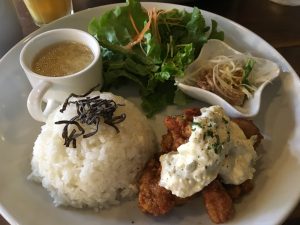
We came back to Derek-sensei’s house in two groups, where we took part in temae. Upon entering the room, we were to proceed to the alcove to take notice of the flower, which brought color to the room, and the pot of water heating on the ground near it. Derek-sensei also talked about the use of darkness in tea rooms, as it is a shared experience for everyone, and even the tea master himself cannot see what he is doing. He relies on careful placement and movement that has been well practiced so that everything is where he expects it to be. If there is uncertainty, or things are misplaced, it can cause fear or discomfort. Additionally, in the darkness itself, we cannot use sight, and thus we rely on our other senses. I was particularly keen towards the noise that was made when he put the water ladle down on its perch and purposely let go of the handle so that it landed on the tatami mat.
We were first served wagashi, in which we broke it open and could smell the fresh yuzu, which the sweets maker apparently had picked from his backyard. It was delicious and fragrant, as the sweet inside of what I believe was red bean, warmness, and soft, chewy, mochi-like outside came together. We watched the ceremonial process of wiping down the tea tools as well, and I was particularly interested in how fluidly he folded the handkerchief he used to wipe down the tools. Every movement was practiced, smooth, simply, and somehow pleasing to the eyes to watch. The sound of the water being poured into the bowls and the pot also perked my ears. The tea was served to us as well, one-by-one, with a fine foam at the top, and we were to raise it up and silently say thanks, for example, to the water that was brought in to make the tea.
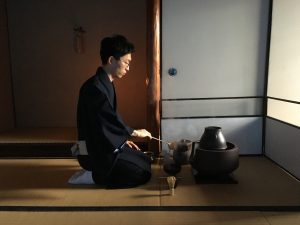
It was important to note the meditative atmosphere that Derek-sensei created. It much reminded me of our first day doing zazen, and also the zen garden that Leah and I sat in a couple days ago, where we also had tea and sweets, looking out onto the garden and experiencing things with all senses while focusing in silence while blocking out the chaotic world that lay outside the temple. In essence, this was temae, focusing on the thing in front of you, wholly and fully, even for a moment. It was something that I felt was well transmitted to me today. As someone that comes from a place where everyone is always going for the next big thing in a rush, I constantly think about the time that I am wasting away, and how I don’t have enough time left, but in reality, as Derek-sensei said, “a second is eternal.” Enjoying something in the now and thinking only about it is quite special in its own right.
We went afterwards to Imamiya Shrine, which specialized in Enmusubi, or romantic relationships. I was absolutely captured by the omamori there, which were beautiful. I hope to add a picture later. We actually visited in hopes that the aburimochi shop was open, as there were two facing each other on the street that had been in business for years, but alas they were sadly closed.
We then split off. I had make a trip to the sakeya, as my host family is visiting me in a couple days and they enjoy sake. My host dad sadly cannot make it, but I know he loves good sake, so I tried to buy something that would possibly fit his tastes. I was unable to find a good craft beer for my host mother, but I did previously purchase some Pom Pom Purin merchandise for my host little sister. We also did some quick stops at Daiso and Spinns again, and had a quick dinner at an udon chain. I actually used to eat udon here every Wednesday after my field placement in Omotesando, and it was very “natsukashii” to be able to eat here again.
We head back early in order to work on our presentations! Well, tried, but this blog post took me more than an hour, so it looks like I lost quite a bit of time. In the meantime, here’s Franky, a real “cuttie.”
